You are reading the older HTML site
Positive Feedback ISSUE 9
october/november 2003
Critical Reception: The 2003 AES Show in New York
by Scott Dorsey
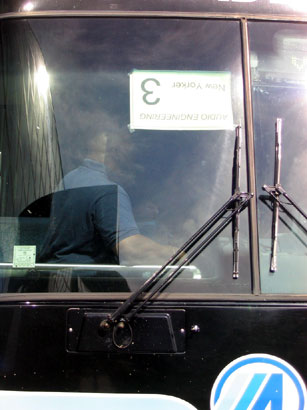
(Photographs by Melissa McDowell; image processing by David W. Robinson)
This year's show was interesting both because it was quite large, returning almost to the pre-September 11 size, and because a large number of regular companies weren't there this year. What really struck me this time was the greatly increased security and bureaucratic runaround; it was a lot more difficult to get tickets and passes than it has been in the past.
EVI wasn't there at all, no media manufacturers were there (other than a few tapes and discs in the corner of the booth at HHB), and Mackie was only showing their new digital console and nothing else. But there were plenty of new faces as well as a lot of the usual old ones, and while there were fewer really innovative items out on the show floor than in previous years, I think the hype level was down a bit.
There was a huge traffic jam on the show floor wherever Les Paul went, and once again he was out seeing the sights and talking to people. It's always good to see the grand old men of the industry still taking interest in the technology, and there were a lot of them them there. Even the notoriously secretive Rudy Van Gelder was on a panel this year.
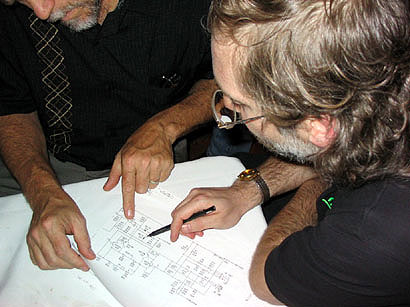
Scott Dorsey (right) studies a schematic
I managed to make it to a couple of tours and a few papers, and I managed to read a few other papers. This article is really just a smattering of things that I found interesting and things that I thought other people in the high end industry would find interesting, rather than a comprehensive overview of the show. So if you wonder why I'm including summaries of papers on mass production of speakers and Indian classical music, it's because I found them interesting. As far as I know, I am the only magazine writer that even bothers summarizing any of the papers, which is a shame since the stuff that goes on downstairs in the paper session is usually far more exciting than what goes on upstairs on the show floor.
There was one item that I really wish I had been able to attend this year. Gabe M. Weiner of Quintessential Sound was one of the finest recording engineers I have ever met, and produced some amazing classical albums during his very short life. While a student at Columbia he became active in the creation of the Usenet rec.audio.pro newsgroup, and was one of the most helpful and open people I have ever met. He died April 8, 1997 of a heart attack. This year, an organ was dedicated in his name at the Central Synagogue in New York and a concert on this organ by Graham Blyth was a feature of the show. Rest in peace, Gabe.
And on that note, on with the show...
Speakers
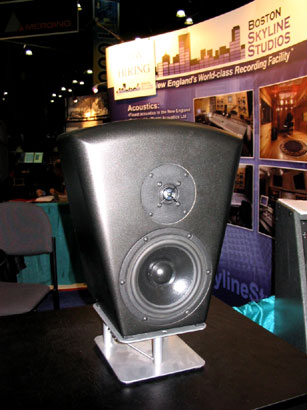
Tannoy was showing off their new Ellipse, which was an oddly-shaped elliptical cabinet with a dual concentric driver and on top a super tweeter for ultrasonic reproduction. To be honest, it didn't sound any different to me than the rest of the dual concentric line (which is pretty good), but then again I was using a CD for auditioning, which wouldn't have any ultrasonic content anyway.
Westlake Audio was showing their BBSM-4 small portable reference monitor; two 4" drivers and a soft dome tweeter. It had surprisingly good low end given the size but was still a bit restricted on the bottom for my taste. I'd have liked to have heard their larger stuff; they are now making a number of large studio monitors that aren't horn-loaded like their traditional designs, but they didn't have them available for auditioning.
DAS, the Spanish speaker folks, were showing off their usual line of PA speakers including some new inexpensive powered models made from molded plastic. But what was FAR more interesting was that they were also showing off raw speaker drivers, including some fairly impressive midrange stuff. If you're interested in speaker design, it might be worth checking out their line although it's primarily oriented toward large PA applications. (Even so, they do still have woofers with Fs as low as 33 Hz, which is a lot better than typical PA gear manufacturers).
Snake Pro also had a line of various pro audio drivers, which looked like some interesting stuff. They've been making speakers in Brazil for the past forty years and only now are starting to get into the American market with some of their products. Thomas Holmquist from the US division was very informative about the line.
NHT Pro was introducing the M-20 monitors which replace their older A-20 design. Very similar drivers, radically different cabinet shape (and the NHT Pro cabinets are always strangely shaped), and a pretty solid sound. These now are being sold with individual monoblock amplifiers designed for the speakers, with the crossovers in the amplifiers, unlike the original A-20 which had a stereo amplifier unit with it.
Earthworks did a great demo with a variety of microphones up in front of a live musician; when I got there they had a really amazing guitarist named Yuri Naukov up in front of the mikes and you could listen to your selection of any of the mikes through headphones live in the room. What was most interesting, though, is that they were also doing playback through their new Sigma 6.3 speakers. These are monitors, configured much like their older 6.2 types with the same Focal tweeter, but with dual woofers, one on either side of the tweeter.
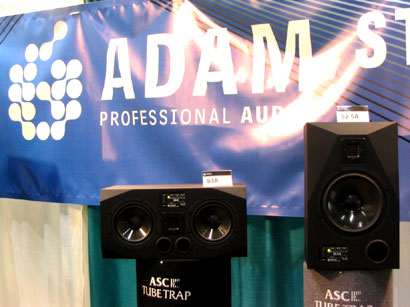
In the ADAM booth they were showing off their standard line of monitors, all based on the old Heil ESS technology tweeters. Top end was a little bit etched on all of them, but it was very clean in the midrange and had a great vocal sound on the old Sinatra records they were playing.
SLS was showing off a range of ribbon-tweeter-based speakers for both PA and recording monitoring applications, and I have to say that some of this gear is amazing. Got a chance to listen to their S8R monitor, which is a great sounding speaker with a very accurate vocal sound and decent low end extension in a small package. Very tight dispersion, though, which results in a small sweet spot but which can be a huge advantage in a live sounding room. They have just come out with a new line of speakers intended for installed work in home theatre systems, and while it's not cheap at all, if it's anywhere near as good as their other lines it's worth checking out.
Stage Accompany was also showing off the ribbon tweeter PA speakers, although most of their smaller line wasn't being shown. They appear to have new US distribution now and have a good chance of actually shipping products. And they do have a huge line, other than just the AXL 36 that they had for demo at the show.
Griffin from Norway was showing off some smaller monitor systems with ribbon tweeters; their large monitors use the Stage Accompany drivers, but the newer mid-field monitors use B&G ribbon drivers and also look very impressive. The larger ones sound amazing clean even at high levels, good enough that I feel bad about having not had a chance to get a serious audition of the smaller system.
FAR, Fundamental Acoustic Research, was showing their line of Tsunami monitor speakers from Belgium. Some very soldly put together cabinets with interesting tweeter designs that looked like a hybrid between a compression driver system and a conventional tweeter. They use a high pressure tweeter device going into a waveguide. Sadly, like the Griffin, I did not get a chance to do a real audition on these.
I also feel bad anout not getting a real audition of the Lipinski monitors, which are D'Appolito boxes with very unusual tweeter mounts; the tweeters are recessed and surrounded by foam. The quick listen that I heard sounded very good, but under the booth conditions it was impossible to get a real sense of what the off-axis effects of the tweeter design were, and how the overall imaging was. That's pretty typical of the show floor, sadly.
Klein and Hummel is now selling their monitors directly rather than through a US distributor. They had a wide variety of different speakers on display, all of which were distinguished by a very natural midrange sound.
ATC Acoustic Engineers had their SCM 12 two-way system at the show. Again very clean midrange, and the ATC stuff is passive unlike a lot of the newer monitors which have integral power amplifiers. Again a soft-dome tweeter and the clean British-style voicing that I tend to like a lot.
Focal, which showed some very impressive larger monitors at the show in Amsterdam, made their US debut and also included a smaller set, the SM8. Very etched top end for my tastes, but a clean sound and, they claim, very extended ultrasonic response. Internal amplifiers on these, but interestingly enough they also have internal DSP processors to perform the crossover work in the digital domain. On a quick listen, they did not sound over processed like some of the devices out there that have tried this. Focal has long been known as a driver manufacturer and it's interesting to see them selling complete systems now.
Linn was showing their new 318A monitor, a smaller unit than the device they introduced at the last show. Very detailed top end, very etched sort of sound, but also extremely clean sounding as you would expect from Linn. It's good to see Linn, long known in the high end, moving into the high grade pro audio world.
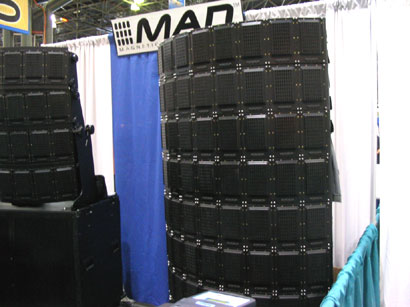
Magnetic Audio Devices had a really interesting large array of small magnetoplanar drivers. On the show floor, the overall sound was very clean and they were quite promising; although they are intended for huge arrays for flown PA systems they might have a future in smaller panel arrays as well. Unfortunately they didn't have any technical information available or any press kits, and the only information they could give me was that their web site was at http://www.getmad.us, although sadly this site does not seem to work with any browser that I have tried so far. [Your editor notes that it seems to work fine with Internet Explorer 6.x.] I'd definitely like more information, being a huge fan of planar speakers in general.
Speaker Papers
Some very interesting stuff this year. Pascal Brunet, Evan Chakroff, and Steve Temme were talking about "Loose Particle Detection in Loudspeakers." Turns out that rattles from loose particles are very easy to hear, but not very easy to detect in automated testing. These folks provide a way to detect and eliminate drivers with rattles in mass large-scale production. If you're curious, check out Preprint 5883.
I gave a rather short paper on "Lamps for Speaker Protection,", in which I showed some of the reasons why using automotive light bulbs in series with drivers for protection did some serious damage to reproduction of dynamics in speakers. Common wisdom in the pro audio industry about how these things work turns out to be quite wrong. Preprint 5881.
Steven L. Garrett and John F. Heake talked about the freshman seminar at Penn State in which they teach basic engineering principles in the guise of speaker design. In "Hey Kid! Wanna build a loudspeaker? The first one's free" they talk about introducing students to resonance and electrical measurements, to logarithmic plotting, mechanical and gas stiffness, and a variety of other concepts, while students build speakers. Preprint 5882.
Brian E. Anderson and Timothy W. Leishman from Brigham Young University gave a talk on "An Acoustics Measurement Method for the Derivation of Loudspeaker Parameters." They showed an entirely acoustic method for calculating most of the Theile-Small parameters of an unknown speaker driver without any connection to the voice coil leads. They showed good correlation with measurements made through electrical methods, but what was very interesting is that with some drivers they found a significant variation in parameters measured with the driver in different orientations and that the consistency was better than measurements made electrically with different methods. Worth checking out if you're at all interested in speaker design. Preprint 5865.
Andrew Bright from Nokia talked about "Tracking Changes in Linear Loudspeaker Parameters with Current Feedback." Recently we've had a lot of new speaker systems that use DSP to compensate for driver nonlinearities. One of the severe problems with this is that as the drivers age, those nonlinearities change, and the compensation no longer is effective. Mr. Bright presents a method where the driver nonlinearities can be derived merely from measurements of current feedback at the amplifier, and from the total moving mass of the speaker (which is not expected to change over time). This allows DSP systems to track changes in speakers as they age. Preprint 5909.
Mark Dodd from Celestion did some investigation into using finite element models for designing compression drivers, in "The Development of a Forward Radiating Compression Driver by the Application of Acoustic, Magnetic and Therman Finite Element Methods." Preprint 5886.
Room EQ
The guys at Rives Audio are making a box called the "Parc Room Mode Eradicator" which claims to use DSD to reduce listening room problems. I find the idea rather misguided and I've never seen any device like that work before, but it's still interesting to see it coming around again. (This from Rives... we use a fully analog approach and compensate only in the bass region leaving the mids and highs untouched. The bass region can be exaserbated by room modes, caused by the boundaries of the room. These accentuate certain low frequencies that are frequently if not impossible to deal with otherwise. The PARC deals with these with a fully parametric notch filtration in the analog domain, providing 3 bands per channel and independent center frequency, Q, and attenuation for each. The analog not only keeps the signal pure, it has the added benefit of inversing the phase shift caused by the room mode. Simple, elegent and very effective...but we do NOT use DSD... Ed.)
Sunil Bharitkar, Philip Hihnes, and Chrys Kyriakakis from the University of Southern California wrote on the "Sensitivity of Multichannel Room Equalization to Listener Position" in which they detail the benefits and pitfalls of using frequency domain equalization to deal with time domain room effects. The math is worth checking out in part because the conclusions verify a lot that we already know. Preprint 5941.
In "Hybrid Equalization of Room for Home Theatre System," Lae-Hoon Kim and his colleagues from the Seoul National University begin with the general basic statement that "For home theatre systems, it is necessary to equalize the room impulse response." The rest of the paper goes on to describe how they propose to do it. As always, I remain very skeptical of the basic premises here, but read the paper and decide for yourself. Preprint 5943.
Todd Welti and Allan Devantier from Harman Industries, in "In-Room Low Frequency Optimization" describe a method for using multiple subwoofers to compensate for low frequency room modes and get even low end response throughout a room without carefully fixing the room acoustics. Their method is actually kind of ingenious, even though it relies on having several channels of low end driver for control, and it's worth checking out if you are at all interested in things like portable systems that will be set up in different rooms without the ability to fix the room itself each time. Preprint 5942.
This paper isn't really a paper about room equalization, it's a paper about how to actually fix room problems so you don't need to try and compensate for them on the electrical side. In "Low Frequency Absorbers — Applications and Comparisons," Dick Noy, Gabriel Hauser, and John Storyk from the Walters-Storyk Design Group measure a number of different bass trap designs in a live room and show coefficients of absorption at different frequencies as well as actual waterfall plots of room impulse response with the different absorbing panels. This is a great paper to check out if you're intending on doing any work with bass traps or bass absorption systems of any sort because it lays out exactly what each method will do for you and shows information on all the major designs in one place. Preprint 5944.
Microphones
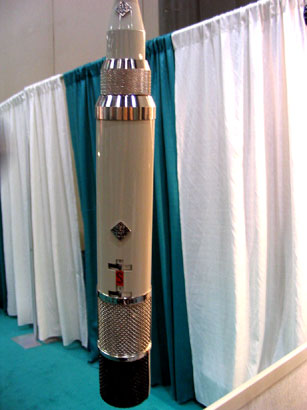
Telefunken North America was showing off a complete line of replica Telefunken microphones, made from the original drawings and some of the original tooling from the old German factory. Frightfully expensive, but then again so are the old used microphones. It's been so long since I've heard any of those mikes I have no idea how accurate the reproduction jobs are, but on the floor they definitely sounded promising. I met Bob Fine's son, Tom Fine, hanging around the booth as well.
Sabra-Som was showing off a wide variety of shock mounts and stands for microphones, varying from simple stereo bars and pop filters on up to fancy bars for Decca trees and 5.1 arrays. All somewhat light duty, but that can be a real advantage when you're flying mikes.
SE Electronics was showing off a variety of microphones from China, but what was most interesting was that they were showing some of the tooling and the diaphragm tensioning gadget that their factory is using. Lots of folks importing these things but not everybody is trying to get the most consistent production, and the SE Electronics display did a good job of showing what they were doing.
I checked out the Sennheiser stage microphones. They had a great demo set up where you could listen to yourself on a variety of different microphones. I am sorry to report that the Sennheiser 441 still has better rejection and a far tighter pattern than any of their newer mikes. The 441 remains the mike to beat for amazingly clean sound and low leakage. I know they don't want me saying this, because they want to discontinue all of that old stuff and push the newer lines, but I just like the 441 more every time I use it. I was hoping at the show that I'd find one of the new Evolution mikes would beat it out, but nothing did.
ACO was showing off a variety of new measurement products, but what I found most interesting was their 7052PH which allows you to use electret-type measurement microphone capsules with phantom power sources for recording work.
BLUE was showing off their new Blue Bird microphone, which is really their first attempt at selling a general purpose microphone that isn't intended for one specific purpose in a mix. It's intended to have fairly flat frequency response rather than particularly tailored sound, and it's their first attempt at assembling a microphone in the, something they had to do in order to deal with the quantity of microphones they're working on. These are going to be sold through Digidesign only, so they'll be bundled with Digidesign interfaces for PCs. As always, Martins Saulspurens was a delight to talk with because he just has so much enthusiasm for sound.
Josephson Engineering was showing off their Series Seven surround microphone, a body with three capsules in it from which five-channel audio can be derived. Although surround is becoming an increasingly big deal at the show and everyone is talking about it, there really aren't many solutions for minimalist surround miking, and this is definitely a step in the right direction.
Positive Feedback Online's own Mike Pappas was conducting a great demo for Neumann/Sennheiser. He had a series of recording made through different Neumann and Sennheiser microphones onto a Genex DSD recorder with the EMM labs converters, which he played back through a set of Avalon Acoustics speakers with a Balanced Audio Technology amplifier and Cardas cabling, all in a small demo room adjacent to the main show. He played back three songs, each recorded with two sorts of microphones, and flipped from one microphone configuration to another during the demo. Sadly the overall imaging was not so good because of the quality of the room available, and there was no real sense of envelopment from the rear channels; it sounded like you were up on the edge of the stage with the audience very far behind you. But even under these show conditions, it was very clear what the differences between the microphones were, and it was really amazing to hear the Basie band, which was just amazingly tight. I'd love to hear these recordings and the same system in a better room, and maybe next year they'll manage that. (Just for completeness, I'll say I liked the KM183 mikes a lot better than the M150s, which had a lot less brass bite to them, and more than the TLM170, which seemed to have severe dead spots in the front of the band. Adding the rear channels definitely did improve the sound quality even though they might not have imaged all that well. Even so they definitely improved the sense of space.) In spite of the usual limitations of the show environment, it was a great demo and some of the better sound I heard at the show this year.
Tape
Mike Spitz from ATR Services was showing off his retrofits and ugrades for Ampex ATR-100 tape machines, and John French from JRF Magnetics was showing off some very fine head assemblies for a variety of machines. There was not a single media vendor at the show, though, other than HHB which was showing a few DAT tapes, CR-Rs and MDs in the corner of their booth. All of the tape vendors were gone this year. I even tried to find a 1/4" machine to play a test tape on for a friend, and I could not find a single operating 1/4" machine anywhere on the show floor. Even the historical exhibit had only a 1/2" deck.
Surround
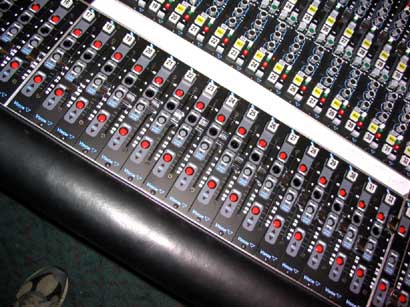
API was showing off their new Vision surround mixing console, and they had it set up with a Mykerinos multitrack DSD system playing back some material that you could mix yourself. It was lots of fun, and I found it a fairly easy console to get around on once I got the hang of it (although the channel strips are WAY too deep for my short arms... the EQ is way too far back for me). Sound? It sounded good. Who can tell at the show? I didn't have much trouble getting a decent mix on the material, though.
Cables
Mogami is now not only making high grade cables, but they have now introduced high grade cable assemblies, pre-terminated with connectors. Very good news for folks looking for good-sounding inexpensive cables. I'm sorry to report that they don't have any with top-grade RCA plugs off the shelf, but they said they could make them up in very small quantities for very reasonable prices. If you like the Mogami material, this could be a good way to save some time and effort as well as money.
Neutrik was showing their new STX series Speakon connectors. Very heavy duty and ruggedized, with a lot of surface area and good clean wiping contacts. Certainly much lower total contact resistance than most 5-way binding posts, and impossible to swap the polarity accidentally on these things too.
Noise
Lots of great papers about interference and noise this year. Jim Brown wrote on "Testing for Radio Frequency Common Impedance Coupling (the "Pin 1 Problem") in Microphones and Other Audio Equipment." Balanced lines for high grade audio employ two lines of opposite polarity and a receiver that eliminates anything common to both lines, but that noise reduction system doesn't work when the signal ground is coupled (often inadvertently) to the chassis. Mr. Brown gave a good overview of the problems and some of the solutions, and then gave some results in testing a variety of microphones and preamps in various ways (one of which included setting up microphones in the near field of an antenna farm set up on ham radio Field Day). Lots of fun if you are interested in RFI. Preprint 5897.
On the other side of the digital/analogue divide, Jon Paul from Scientific Conversion was talking about "The Effects and Reduction of Common-Mode Noise and Electromagnetic Interference in High-Resolution Digital Audio Transmission Systems." Higher clock rates make keeping jitter levels down and keeping clocks stable are both more important and more difficult than they were at lower rates. This means keeping induced noise out of digital systems is more critical. Mr. Paul discusses pulse transformers and common mode chokes and demonstrates how they can easily improve the stability of digital signals. It must be admitted that as a manufacturer of such devices, he has a bit of an interest in promoting them, but even so his data were pretty convincing and his results correlate well with others' experiences. If you're at all interested in digital audio interfaces, check out Preprint 5879.
Once it's too late to do anything to prevent induced noise, it's time for single ended noise reduction. CEDAR was showing both their standard DNS1000 hardware noise reduction box, and also the new Cambridge computer-based system. The DNS1000 is intended for film production work and allows a huge variety of different noise reduction methods to be used, all from a very small box with a simple but powerful slider user interface. The Cambridge is a DSP box with optional software modules that handle twenty different sorts of more specific noise reduction, pretty much intended to replace their earlier generation of outboard hardware devices. The CEDAR stuff in general is extremely powerful and has long been the standard for noise reduction systems.
On the subject of single-ended noise reduction, Ching-Shun Lin and Chris Kyriakakis from the University of Southern California had a paper entitled "Multi-Frequency Noise Removal Based on Reinforcement Learning" in which they used a standard neural network model, trained it with sample signals, then evaluated the ability to remove random noise from test signals. Seemed a bit off the wall to me, but the test samples they had to show seemed impressive. Preprint 5966.
Amplifiers
Lab.Gruppen from Sweden was selling their new FP series of power amplifiers with switching supplies but conventional output stages. While I'm still a little leery of the whole switching supply thing, these amps allow very high current on peaks, and weigh very little, which can be a big deal in a lot of applications. We're talking 6400W into a 2-ohm load continuously, out of a box that only weighs 22 pounds.
As in previous years, everybody was really big into the whole Class D power amplifier thing. Zetex was showing off their line of new ICs for Class D amplifiers, though sadly they didn't have any of the discrete transistor stuff there at all (which I consider a lot more interesting). I have to admit that I passed by a lot of the folks manufacturing Class D systems this year, just because I don't find it all that interesting, and so I missed a lot.
ICE was showing off a number of Class D amplifier modules intended for installation into subwoofers and other powered speaker systems. They're mostly selling to manufacturers on an OEM basis, but they are a division of Bang and Olufsen and seem to at least try to have good sound in mind. Incidentally, Karsten Nielsen and Lars Fenger from B&O were also giving a talk on how these things work, in "The Active pulse modulated Transducer, A novel audio power conversion system architecture." Preprint 5866.
D2Audio was also showing off their Class D amplifier chip, and the article from Steven Harris, Jack Anderson, and Daniel Cheng of D2Audio gave some details on their polyphase design. "Intelligent Class D Amplifier Controller Integrated Circuit as an Ingredient Technology for Multi-Channel Amplifier Modules of Greater than 50Watts/Channel" is Preprint 5947.
Rosalfanso Bortoni, Sidnei Noceti Filho, and Rui Seara from the Federal University of Santa Catarina in Brazil wrote about "Comparative Analysis of Moving-Coil Loudspeakers Driven by Voltage and Current Sources." Now, this sounds like a loudspeaker paper, but in truth it's also a paper about amplifiers because it's another step toward modeling how tube amplifiers (which are normally transformer-matched to the speaker load) make speakers sound different than transistor amplifiers (which are normally a lower output impedance than the load and act like voltage sources). The authors take the normal Theile-Small models of several speaker designs and extend them to take into account many of the nonlinear effects and then show how they differ with different source impedance. Preprint 5910.
Mr. Bortoni, along with Homero Sette Silva, also talked on "Loudspeakers' Electric Models for the Study of the Efforts in Audio Power Amplifiers." In this paper, the authors give electric equivalent circuits for a wide variety of different speaker configurations as well as their transfer functions. Although there is no inclusion of nonlinear effects, this is still a good guide for anyone building amplifier output stages who is interested in stability into different speaker loads. Preprint 5911.
DSD
This is clearly the year for DSD stuff, and the Sony and Philips folks were out in force, as well as a lot of other folks like Meitner (selling some very nice converters), and Genex (selling native DSD hard disk recorders).
In the papers sessions, Michael Page, et al, from Sony Oxford were talking about "A universal interface on Cat-5 cable for high-resolution multichannel audio interconnection" and describing an extension to the MAC-DSD audio interface that could also handle PCM as well as DSD audio. The SuperMAC interface carries 24 channel DSD or 96 Ksamp/sec 24 bit PCM bidirectionally with an external clock, using standard CAT-5 cable. They describe the general interface characteristics as well as some sample interface hardware and a router. Preprint 5878.
Up on the show floor, Sony was showing off SuperMAC hardware interface boards that could be integrated into commercial products. But they also had a variety of other modules also using a standardized buss they call D-MAP, including a dynamics processing DSP board, and a combination summing and EQ DSP board. These D-MAP cards can be dropped into commercial designs, or into an evaluation board that Sony sells, which allows four modules to be controlled through a Firewire interface. Because of the speed of the DSD data stream, pretty much all processing right now needs to be done with dedicated hardware rather than general purpose DSP chips, and this is a convenient and inexpensive way to integrate dedicated hardware into a product.
As an example application, they were showing a Sony Surround Preamp Technology Demonstrator, a little 5.1 box that could take DSD or PCM data and provide analogue outputs to an amplifier. They were also showing off a sample SuperMAC routing box which could be controlled by a PC and allowed a lot of processing to be done as well as just point to point routing.
In addition, Sony showed the Audiolink 2 made for them by Nine Tiles, which allowed DSD data over the SuperMAC interface to be clocked and dropped onto ATM wide-area data networks using the new AES47 Audio-over-ATM standard.
Philips was showing off a variety of software modules for SACD processing, which are available for developers to license and drop into their products, and that's worth checking out if you're interested in how the DSD stuff really works inside.
Recorders
Nagra wasn't showing off any of their home audio gear, which is a real shame since in previous shows they did have some of their very fine high end home equipment.
Nagra did just introduce the Nagra DAC, a very high grade DAC for home stereo applications, with integral volume control and analogue input as well as switching, so it can act as a simple line stage as well as a DAC. Great looking box to base a home system around. They had documentation on the box, but sadly didn't have one for audition at the show. They did have the new Nagra V available, a little 24 bit location recorder that records to removable hard disk media.
HHB was showing the Portadrive PDR 2000 again, a very nice little six channel hard disk recorder intended for field work like film sound recording, and this time they say it really is going to be available, not like the last time they showed it. It's a very slick little box and I'm looking forward to seeing it once it really is available.
Fostex also had a two-channel hard disk field recorder, the FR-2, again for the location recording folks. They didn't have much hard information on it, but it looked to be solidly built.
Transformers
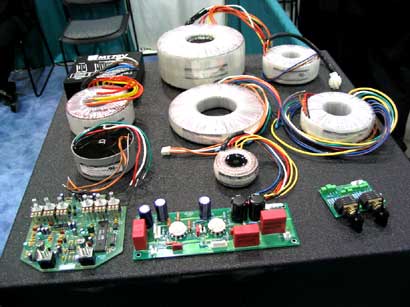
A bunch of transformer companies at the show this year! As usual, Per Lundahl was showing his line of extremely high grade audio transformers, which include some fine tube amp output transformers that were recently introduced, as well as some excellent microphone input transformers. Some good news is that now Kevin Carter of K&K Audio in Apex, NC is carrying the Lundahl transformer line in the US, which will make ordering much easier.
There were also some Asian manufacturers at the show. Keen Ocean was showing a line of toroidal power transformers made at their factory in China, as well as some impressive-looking audio output transformers wound on toroids and some 70V line transformers that actually looked well-made, compared with the typical Asian production.
The folks at Sunrise Electric and Electronic Company in Guandong were there for their first year. They had a line of laminated iron core power transformers for various power supplies, but they also had a line of very high power transformers intended for specialized applications like welding and subway car motors that were interesting to check out just to see how wide a range came from one outfit. Xiao Juncheng was very interested in showing how this stuff was made.
Converters
The guys from AKM Semiconductor were showing off their lines of converters and filters for audio as well as digital. These guys make a large percentage of the converters and codecs currently in use these days and they make some very high quality chips as well as inexpensive mass-market parts. This year they were talking about a wide variety of 192 Ksamp/sec parts which they now have available.
Lavry Engineering had a neat thing. These are the guys who have in the past mostly made very high grade converters for audiophile applications. They have now gone in the opposite direction, and are making a 2-channel 16 bit D/A converter that plugs into the Firewire port of a laptop, and has two mike level inputs. Since it uses the existing Firewire drivers, it's supported by just about every operating system out there (it runs fine on a Mac Powerbook even, though that isn't guaranteed). And it's $250. There's no phantom power, but this really sounds like a great gadget to get into home recording.
As always, someone was doing a study on audibility of higher sampling rates. This year, three folks from the NHK Laboratories in Tokyo wrote on "Perceptual Discrimination between Musical Sounds with and without Very High Frequency Components." It was a better-conducted experiment than most of them, though the results were inconclusive. If you're curious about ultrasonic stuff, check out Preprint 5876.
Weislaw Woszcyk from McGill in Canada had a paper called "Physical and perceptual considerations for high resolution audio" which was a great overview on the arguments for and against high sampling rates and ultrasonic reproduction. He makes the general surmise that much of the improvement is the result of improved temporal resolution and discusses this in detail. This was a really great presentation and the paper is worth reading just to see the various arguments from all sides. Preprint 5931.
Cirrus Logic had a wide variety of new converter chips out, including a newly designed converter that can alternately handle both DSD and PCM audio without any transcoding or decimation internally. This is a big deal for players to handle both SACD, CD, and DVA-A accurately. Bruce Duerwer, John Melanson, and Heling Yi wrote a paper abou it, called "A Multi-bit Delta-Sigma DAC with Mismatch Shaping in the Feedback loop." Preprint 5919.
M. O. J. Hawksford from the University of Essex in the UK wrote about "Parametrically controlled noise shaping in a variable state-step-back pseudo-Trellis SDM." This is a sigma-delta modulator configuration for converters that can obtain a higher signal to noise ratio than conventional Trellis modulators. Preprint 5877.
Erwin Janssen and Derk Reefman from Philips Research Systems talked on "Advances in Trellis based SDM structures" in which they show a new algorithm that offers better performance than Trellis noise shaping with lower processing cost. Preprint 5993.
In a similar vein, James Angus of the University of Salford wrote on "Efficient Algorithms for Look-Ahead Sigma-Delta Modulators" in which he discusses several variants on the Viturbi algorithm for Trellis noise shaping, with better performance. Preprint 5950.
Joshua Reiss and Mark Sandler wrote about "Dither and noise modulation in sigma delta converters" in which they continue to add fire to the current debates about whether adding dither directly into the A/D quantizer is a good thing or not. They argue that how dither works on these systems depends on the quantizer configuration and that it is inherently different than with ladder converters. Preprint 5935.
Thomas Holm Hansen and Lars Risbo from TI in Denmark talked about "Adaptive Digital Calibration of Over-Sampled Data Converter systems" and described a way in which converter error could be determined on the fly and then compensated for in actual use, which allows lower tolerance components to provide considerably higher performance. Preprint 5949.
Oh yes, and Apogee was showing their Big Ben universal digital clock. All kinds of reference clock signals at all kinds of different rates, and if their numbers are to be believed, very good stability and extremely low jitter.
More ICs
Analog Devices was showing off a whole lot of chips, which included everything from op-amps to converters but what excited me most was that they are now selling the SSM2019 chip, which is a self-contained preamplifier front end on a chip that replaces the (rather poorly performing) SSM2017 and the (long discontinued) SSM2016 and SSM2015 preamp parts. It's available in a package that is pin-compatible with the old SSM2017 as well as in a larger 16-pin package for new designs. Definitely looks like it's worth checking out.
The TI guys were also showing off their line of ICs, from high grade TAS3103 DSP processors and SRC4192 sample rate converters, to the Burr-Brown op-amp lines. They're also showing off their slightly older SSM2017 replacement, the INA163.
The guys from THAT semiconductor didn't have their SSM2017 replacement, which they have been promising for several years now, but they did have their new dynamics processing chip, the THAT 4320. This is oriented toward low power applications such as wireless microphone devices, but could be used as a general dynamics processing element in all kinds of things.
Wavefront Technology was there. These are the folks who used to be the semiconductor division of Alesis, and now that Alesis is sort of coming apart, they are now an independent company selling ICs to the mass market. This includes the usual range of A/D and D/A converters like their 24-bit AL1101 and AL1202 but also some otherwise difficult to obtain things like ADAT lightpipe components (their AL1401 and AL1402) for folks designing multichannel interfaces, a general purpose DSP unit (the AL3101/2), and a hardware digital reverb engine (the AL3201B). All sorts of nifty hardware.
Other Components
Both Groove Tubes and Electro-Harmonix were showing off their lines of high grade selected tubes imported from a variety of factories. The Electro-Harmonix/New Sensor guys also had some very fine looking sockets as well.
Custom Electronics from New Jersey was showing off some very impressive capacitors, including some Teflon capacitors with amazingly good numbers on them that looked like they might be really top notch for audio applications. Michael Schulte there also had film and foil capacitors in a number of other film types, though sadly not the polycarbonate that has become a rarity in the past couple years. These guys also do custom potted modules for high voltage applications, mostly for the military.
Kilo International had some very, very impressive machined aluminum knobs. Really nice stuff. I'd never heard of them, but I really like the knobs and they turn out to be available from Digi-Key. Great for new projects and also for retrofitting older gear.
Magazines
There were folks there from Mix, Speaker Builder, Canadian Musician, Professional Sound, Live Sound, Sound and Communications, Audio Media, Recording and Musico Pro, SRO, and more other magazines than you can shake a stick at.
Miscellaneous
One of the more interesting things at the show was the Gordon mike preamp. All film-and-foil capacitors, and rather than having any attenuation at any point in the signal path, there were a variety of different stages of different gains that could be switched in and out of the signal path. Very interesting approach to design, but one that gives you the best possible headroom. These folks definitely have the audiophile no-holds-barred approach to design, and while some things I saw in the box seemed a bit over-the-top, that's just part of the charm.
Steve Puntolillo from Sonicraft was showing off their A/D transfer services. They have a wide variety of different analogue and digital machines and offer tape transfer services for folks wanting to transfer older formats to new ones with the highest possible care.
Sony was selling a new rackmount CD player, the CDP-D12. The transport looked a bit light for high-grade home service, but it might well be worth checking out for running into a top-notch outboard DAC since it has both optical and coaxial S-PDIF outputs, something becoming rare on consumer models.
Don Strahle from Acoustical Solutions in Richmond, VA, was showing off their extensive line of acoustical control products. Everything from foam and hanging fibreglass devices on up through diffusers and acoustically transparent cloth for speaker grilles and similar applications. These folks used to be the acoustical division of Alpha Audio many years ago, and remain long after the original Alpha studios closed.
Eddy Brixen from Denmark was talking about "Audio Production in Large Office Environments" and had a good overview of the various pitfalls in attempting radio broadcast production in large office environments and some solutions for some of the more serious problems. Preprint 5949.
Under Cover was showing a wide variety of custom-made nylon covers for all kinds of musical and audio equipment. Great stuff.
Prism Sound had the latest version of their DScope analyzer, which is a very convenient all-in-one audio test system. Very slick and convenient for working on digital electronics or analogue.
Dan Kennedy from Great River was showing off a really fine sounding EQ, the EQ-1NV digitally-controlled analogue equalizer. Very clean and very controllable. It was great just watching the faces of people as they tried it out and discovered how clean it really was.
On the subject of analogue equalization, David Berners and Johnathan Abel from Universal Audio were attempting to alter the standard bilateral transform used to perform shelving filters in the digital domain, in order to more accurately model the errors in a real analogue filter. In "Discrete Time Shelf Filter Design for Analog Modeling" they show three types of resonant shelf filters that closely model the real thing. Preprint 5939.
Seven Woods Audio, headed by Christopher Moore, the inventor of the original Ursa Major Space Station reverb unit, is now making a box called the SST-206 which really does emulate the old 1970s Space Station. It sounds amazing. It sounds just like the Space Station, which isn't an accurate reproduction of a room but is a particular sound that is really great for a lot of work. The new box looks just like the remote control for the original, which says a lot about how technology has changed.
Arvindh Krishnaswamy talked "On the Twelve Basic Intervals in South Indian Classical Music." He claims that the tonal scale normally used by South Indian musicians can be simplified, and that although common wisdom in the past has indicated a 22 note scale is used, that in reality this can be reduced down to a 12 interval scale with flexible intonation. I'm not really sure why this wound up at an AES show, but I can still see some applications in the audio industry (such as with folks designing auto-tuning systems), and anyway it was kind of fun. Preprint 5903.
Charith Giragama et al. continued their very interesting research into how we talk about sounds, with "Relating multilingual semantic scales to a common timbre space — Part II." These folks presented native speakers of several different languages with some different guitar tones and a list of descriptive adjectives. They were asked to select adjectives to describe the sounds. People speaking the same language tended to pick the same words for the same sounds, but it did not at all carry over into other languages. Words with the same meaning were used for very different sounds. If you are interested in how we talk about different sounds (which is always a huge bone of contention in the audiophile community — what does "warm" mean anyway?), you should check out Preprint 5895. [This sounds like a very interesting subject. The language of fine audio aesthetics/reviewing is a very challenging realm. — Ye Olde Editor]
How do you select people for listening tests? Where do you find them, how do you ensure they are skilled listeners, how do you make sure they are articulate about what they hear? David Isherwood and his colleagues from the Nokia Research center go into detail about their methods for putting together listening panels in "Augmentation, Application and Verification of the Generalized Listener Selection Procedure." Preprint 5894.
The THD metric for distortion was a breakthrough when it first came out. In the thirties and forties when amplifier topologies and technologies were all similar and when distortion levels were comparatively high, it correlated well with perceived distortion levels. Today it's a laughingstock and bears no resemblance to perceived effects, but manufacturers still keep using it on data sheets. In "Auditory Perception of Nonlinear Distortion," Earl Geddes and Lidia Lee present a more advanced way of looking at distortion problems, show a new metric, how it's derived, and how it correlated well with perceived distortion effects in listening tests. (Preprints 5890 and 5891)
Quolle had a lot of neat stuff... not only their field mixers like the izm25 digital location recording console, but also the SRX-422 remote control unit and the izm806 synchronization box, intended for video post-production folks. But what was really weird is that they were breaking out of their usual post-production market with the izm701 tube mike preamp. Quolle is a division of Tamura, long known for good microphone transformers, but this box actually uses the Lundahl transformers on the front end, then a 12AX7. Does it sound good? I couldn't tell, and it does have a lot of solid state stuff inside, but it's definitely worth a listen.
Cooper was showing a newer version of their modular field mixers. The CS 208 v.2 is intended for location recording work and now can be configured with optional A-D converters. Their previous field consoles were very nice sounding and extremely rugged and this is a continuation of those designs. They also were showing the CS 104, a smaller non-modular field mixer intended for ENG applications and other location sound applications where small size is essential and you can get away with only four input channels. Dan Dugan was showing off the mixers, along with a lot of other location sound gear.
SSL, maker of large mixing consoles, has come out with a line of rack mount boxes that basically have the same electronics used in the console lines. They have a compressor, which is identical inside to the buss compressor on the SSL G series consoles, a multichannel compressor that gives five or six linked channels of buss compression, a four channel mike preamp (using the same electronics from the SSL 9000K series consoles), and the Xlogic Channel, which is basically a channel strip from a 9000K console built into a small rack mount cabinet. With large numbers of productions moving to workstations, this is a way for engineers and producers to get familiar sounds without having to move to a large format console.
A-Designs was showing their MP-2r tube preamp, a clean and simple pentode input design with Jensen input transformers, the ATTY passive attenuator, and the REDD direct box. All nicely-made gear at a reasonable price.
Xilica from Canada was showing off a number of interesting DSP boxes, all handling high rate PCM audio but with internal floating point hardware. Their DSPX Matrix boxes do internal signal switching in a small matrix, but also include modules for adjusting level, EQ, delay, limiters, gates and the like. They also make something called the DLP-4080 that is specifically designed as a speaker crossover but with additional processing ability as well. All of these are intended to be controlled from an IBM PC or a MIDI controller, over RS-232 or MIDI interfaces.
Acousti-Lock had nifty cabinets that used heat pipes so you could stick your noisy computer systems into a box and put it in the corner and not hear it at all. They claim 32.5 dBA noise reduction, which is an awful lot. Very nice things to have.
Livewire Remote Recorders had their remote truck on display, and it was a really slick setup. Dual Ampex MM-1200 recorders, but also DA-88 digital recorders, ProTools workstations, all kinds of stuff. And all configured in an 18-wheeler with a trailer that has an expanding center section, so the total amount of space is considerable inside. Very ingenious design and ingenious use of space. I work in studio control booths that are much smaller.
Once again, the House Ear Institute was performing free hearing tests and also giving out pamphlets and advice on hearing preservation. These guys are worth coming to the show for alone, even if you don't see anything else. Not only are they providing valuable information about keeping your hearing, they also have a lot of information on how hearing works, and just their presentation on detecting hearing problems in infants by measuring brain stem activity as the child is presented with test signals is worth the trip.
Plangent Processes was apparently demonstrating a system that looks for residual bias frequency on playback, synchronizes to it, and thereby plays tapes recorded on machines with high flutter levels with considerably lower amounts of flutter. The demo was amazing, and the whole idea of doing this sort of thing is so incredibly exciting that it's worth mentioning here at the very least, and anybody trying to get higher quality sounds out of existing masters is amazing. These guys have brought in some amazing folks to work on their systems, and what they are looking at isn't just very audible and dramatic flutter but also much more subtle effects caused by sidebands created on pure tones (much as jitter on digital converters). They have a completely new interpolation algorithm to do the speed control once they detect the actual pilot signal. The general effect is a more clean sound, and greater perceived depth, I think.
Tours
I just want to put in a couple good words for some of the technical tours at the show this year. We went on only two of the many interesting tour sessions.
The first of the tours we managed to get on was to the Loews' Jersey theatre, a huge 1929 movie palace that was scheduled for demolition in the 1980s, but which was purchased by a volunteer group and which is being restored to its original condition. Most of the projection booth isn't original, but they do have a pair of Western Electric projector systems for sound-on-disc Vitaphones that they are getting running, with huge lamphouses that take enormously fat 13.5mm arc carbons to get the light intensity up. Altec speakers on stage, Altec amplifiers, Altec surround speakers, and probably the only operating Perspecta decoder system in the world. The interior of the theatre has clearly had a huge amount of work done to it, and it is at least stabilized. While it looks like it will be quite a few years before the place is up to its original glory, it's still an amazing sight. And Ron Hutchins from the Vitaphone project was there to talk about restoring old Vitaphone films, while Colin Egan and Bob Eberenz talked about the booth and hall restoration.
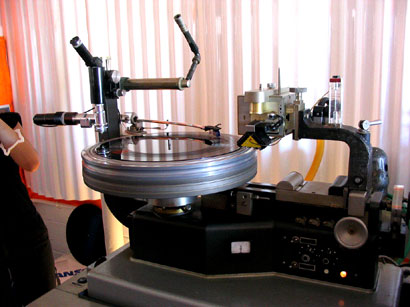
We also took a trip down to the
Conclusion
The AES show is always fun. This was the first American show since the rather downsized one after 9-11, and it was interesting to see who decided to come back this year and who didn't. DSD seems to be the big deal this year, and surround stuff is expanding more and more. It'll be an interesting future for all of us.
